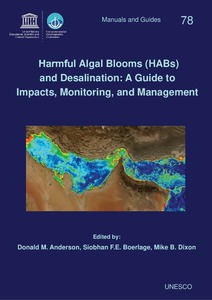Bloom prevention and control.

View/
Average rating
votes
Date
2017Author
Anderson, Clarissa R.
Sellner, Kevin G.
Anderson, Donald M.
Status
Published
Metadata
Show full item recordAbstract
Harmful algal blooms (HABs) are a serious and growing problem to many sectors of society,
including the desalination industry. The many problems that HABs present for seawater
reverse osmosis (SWRO) desalination plants include: 1) the production of dangerous toxins
that have the potential to contaminate treated water; 2) high algal biomass that clogs intake
filters; and 3) contributing to biofouling of equipment and SWRO membranes.
It is important to limit the impact from HABs by preventing blooms from reaching SWRO
plants in the first place, while also reducing their effects in the event that ingress to the plant
has occurred. Many of the management actions taken to respond to HABs can be termed
mitigation – i.e., dealing with an existing or ongoing bloom, and taking whatever steps are
necessary or possible to reduce negative impacts. Mitigation strategies can be classified into
two categories, precautionary impact preventions and bloom controls (Kim 2006; Anderson
2004). P.....
Title of Report
Harmful Algal Blooms (HABs) and Desalination: a Guide to Impacts, Monitoring and Management.Editor(s) of Report
Anderson, D.M.Boerlage, S.F.E.
Dixon, M.B.
Page Range
pp.205-222Publisher
Intergovernmental Oceanographic Commission of UNESCOParis, France
Series;Nr
Intergovernmental Oceanographic Commission Manuals and Guides;78Document Language
enSustainable Development Goals (SDG)
14.1Best Practice Type
ManualCitation
Anderson, C. R.; Sellner, K. G. and Anderson, D. M. (2017) Bloom prevention and control. In: Harmful Algal Blooms (HABs) and Desalination: A Guide to Impacts, Monitoring and Management. (eds. Anderson D. M.; Boerlage, S. F. E. and Dixon, M.B.) Paris, France, Intergovernmental Oceanographic Commission of UNESCO, pp. 205-222 (IOC Manuals and Guides No. 78). DOI: http://dx.doi.org/10.25607/OBP-312Collections
 Repository of community practices in Ocean Research, Applications and Data/Information Management
Repository of community practices in Ocean Research, Applications and Data/Information Management